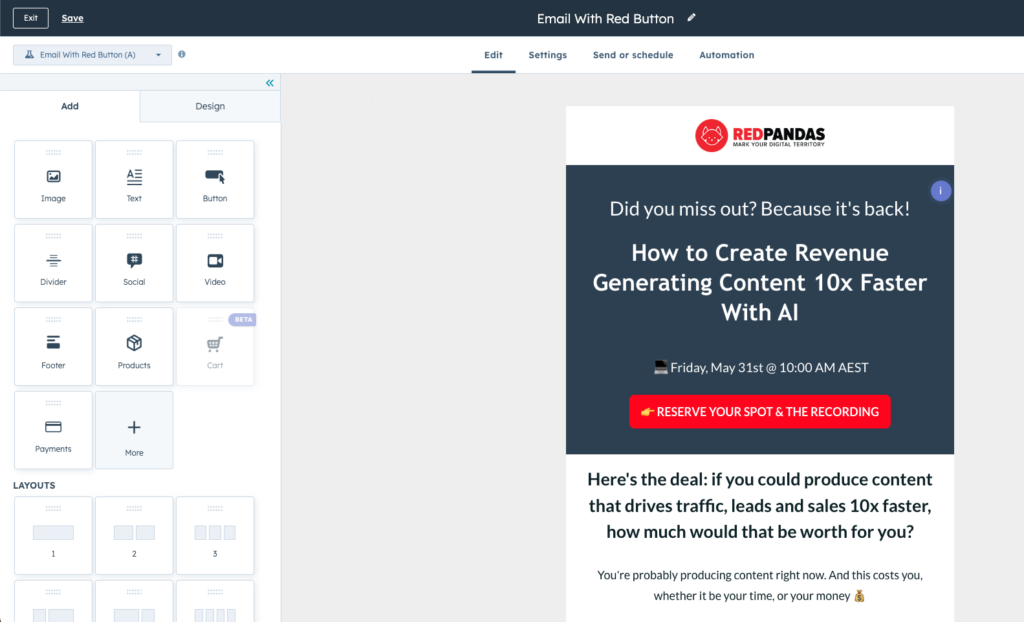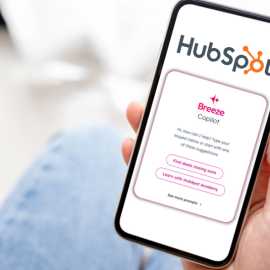Dell reported a 300% increase in conversion rate from A/B testing and studies show that conversions may increase up to 400% with proper A/B testing. It’s clear that A/B testing can improve your bottom line. If you’re using HubSpot but not utilising A/B testing, you may be missing out on conversion opportunities. If you’re already using A/B testing, read on, because you’ll learn some best practices to keep in mind when running your tests.
As a marketer or business owner, you know that every detail counts.
From subject lines to call-to-action buttons, each element can significantly impact your campaign’s success.
But how do you know which elements to tweak for the best performance?
This is where A/B testing comes in.
By comparing two versions of a campaign element, you can identify what works best and make data-driven decisions to optimise your strategy.
We’re constantly running A/B tests, both for ourselves and our clients. We’ve come to learn how to do it properly, mistakes to avoid and the best practices.
In this article, you will learn how to conduct A/B testing in HubSpot, from setting up tests to analysing results and implementing best practices. By the end of this article, I bet you’ll be excited to run an A/B test using our method.
What is A/B Testing?
A/B testing, also known as split testing, is a method of comparing two versions of a marketing asset to determine which one performs better.
By creating two variations (A and B) and exposing them to different segments of your audience, you can measure which version drives more engagement, conversions, or other desired outcomes.
Key Components of A/B Testing
- Variable: This is the element you want to test, such as an email subject line, call-to-action button, landing page layout, or ad copy
- Control (A): The original version of the marketing asset
- Variation (B): The modified version of the marketing asset
- Metrics: The criteria you use to measure performance, such as click-through rates, conversion rates, or open rates
- Audience: The segments of your audience that will be exposed to the control and variation
How A/B Testing Works
- Hypothesis: Start with a hypothesis about what change might improve performance. For example, “A shorter subject line will increase email open rates”
- Create Variations: Develop two versions of the asset – the control (A) and the variation (B). Ensure the changes are significant enough to potentially impact the results and don’t change anything other than that one thing you want to test
- Split Audience: Randomly divide your audience into two groups. One group will see version A, and the other will see version B
- Run the Test: Launch the test and run it for a sufficient period to gather meaningful data
- Analyse Results: Compare the performance of the two versions based on your chosen metrics. Determine which version performed better and use these insights to inform future campaigns
But do you really need to implement A/B testing?
Why A/B Testing is Important
A/B testing is a crucial tool for any marketer aiming to optimise their campaigns and achieve better performance.
Here are some key reasons why A/B testing is essential:
1. Enhances Campaign Performance
A/B testing allows you to identify which variations of your marketing elements perform better. By testing different versions and implementing the best-performing ones, you can continuously improve your campaigns.
For example, if you find that a specific call-to-action button colour increases click-through rates, you can use that insight to boost conversions across all your campaigns.
2. Informs Data-Driven Decisions
Instead of relying on assumptions or gut feelings, A/B testing provides concrete data on what works and what doesn’t. This empirical approach enables you to make informed decisions that are backed by real-world evidence, leading to more effective marketing strategies.
3. Improves User Experience
By testing different variations, you can discover what resonates most with your audience, thereby enhancing their experience.
For instance, if a particular landing page layout results in higher conversion rates, you can design future pages with similar elements to better meet user expectations and preferences.
In other words, A/B testing doesn’t just influence the results in the test you’re running, but also all other future efforts as you use the findings to guide future efforts.
4. Reduces Risk
Implementing untested changes in your marketing campaigns can be risky and may lead to negative outcomes.
A/B testing mitigates this risk by allowing you to experiment with small changes on a limited scale before rolling them out broadly.
This way, you can avoid costly mistakes and ensure that your modifications have a positive impact.
5. Increases Conversion Rates
One of the primary goals of A/B testing is to improve conversion rates. By systematically testing different elements, such as headlines, images, or offers, you can identify what drives the most conversions.
This iterative process helps you fine-tune your campaigns for maximum effectiveness.
6. Optimises Resource Allocation
Marketing resources, such as time and budget, are often limited. A/B testing helps you allocate these resources more effectively by focusing on strategies and elements that deliver the best results.
For example, if a certain type of email content consistently outperforms others, you can invest more in creating similar content.
7. Facilitates Continuous Improvement
Marketing is an ongoing process of refinement and optimisation. A/B testing fosters a culture of continuous improvement by encouraging regular testing and analysis.
This iterative approach ensures that your marketing strategies evolve and adapt to changing market conditions and customer preferences.
By leveraging A/B testing, you can achieve better campaign performance, make data-driven decisions, and continuously optimise your marketing efforts for improved results.
So, how can you set up an A/B test in HubSpot?
Setting Up A/B Testing in HubSpot
Conducting A/B testing in HubSpot is a straightforward process that can yield significant insights into your marketing campaign performance.
You can find HubSpot’s official guides to set up A/B testing in HubSpot below:
We’ll also go over how to set these up below.
How to Create a Landing Page A/B Test in HubSpot:
Step 1: Click on Content on the left side bar & navigate to Landing Pages

Step 2: Click on ‘Create’ and select ‘Landing Page’

Step 3: Name your page and click ‘Create page.’ Finish designing your page before moving on to the next step as this will save you time later

Step 4: On the left hand side, select the test tube icon and click ‘Run A/B test’

Step 5: Select ‘A/B test’

Step 6: Name both of your variations with something that will help you recognise their differences
For example, if you’re split testing whether button colour has an impact on conversions, you could name them:
- My Page – Yellow Button
- My Page – Black Button

Step 7: You can now select each option in the top left and make changes accordingly
On the top left, you can select either variation. Select the second variation and make the changes you want to test. Before publishing your page, select each variation to ensure they both are looking how you want them to.

You can then publish your page and your split test will automatically run.
Step 8. Review your results to determine the winning variation
The first step is to go to Landing Pages as you saw in step 1. Then, hover over your landing page and select ‘Details.’

Click on ‘Test Results’ and you will be able to see the data related to your split test.

Use these insights to inform your future campaigns and implement the winning variation more broadly.
How to Create an Email A/B Test in HubSpot:
Step 1: Go to Marketing > Email

Step 2: Click on ‘Create Email’

Step 3: You can choose ‘Regular’ or ‘Automated’

Step 4: Select ‘Create A/B Test’ button in the top left

Step 5: Fill out the options for your A/B Test

Here’s what these options mean:
- Choose a name for version A: Name for the first version of the email being tested. Example: “Email With Red Button.”
- Choose a name for version B: Name for the second version of the email being tested. Example: “Email With Yellow Button.”
- Choose A/B distribution: Select the percentage of recipients to include in the test. The remaining percentage will receive the winning version automatically. Example: 35% of recipients get version A, 35% get version B, and 30% get the winning version after the test. If you choose 50% for each option, you won’t be able to edit any of the other options and you’ll see a screen like the below:

- Winning metric: Select the metric used to determine the winning version of the test. Example: If you’re testing the subject line, you might want to select ‘Open rate’, which measures the percentage of recipients who open the email, and represents the effectiveness of the subject line. Or if you want to test how many outbound link clicks you get in your email once opened, you might select ‘click through rate’ on the dropdown
- Test duration: Set the length of time the test will run before determining a winner. Example: 8 hours. Generally, you want to pick a time that is long enough for users to receive and interact with the email
Step 6: You can now select each option in the top left and make changes accordingly
On the top left, you can select either variation. Select the second variation and make the changes you want to test. Before publishing your page, select each variation to ensure they both are looking how you want them to.

Note that any changes you make in ‘Edit’ or ‘Settings’ mode will apply to only the variation you are editing. You can see the edit and settings tabs below:

Step 7: To view the performance of your A/B Test, follow step 1 from the start to navigate to emails, hover over your email and click on ‘View Performance’

Step 8: Click on ‘Test Results’

You should be able to see the data between the two emails as you can see in the image below.

By following these steps, you can effectively set up and run A/B tests in HubSpot, leading to better campaign performance and more data-driven decisions.
Best Practices for A/B Testing in HubSpot
To maximise the effectiveness of your A/B testing efforts in HubSpot, it’s important to follow best practices.
These guidelines will help you design, execute, and analyse your tests more effectively, leading to better insights and improved campaign performance.
1. Define Clear Objectives
Before starting any A/B test, clearly define what you want to achieve. Your objectives should be specific, measurable, and aligned with your overall marketing goals. For example, you might aim to increase email open rates by 10% or reduce landing page bounce rates by 15%.
2. Test One Element at a Time
For accurate results, focus on testing a single element at a time. This ensures that any differences in performance can be attributed to the specific change you made.
Common elements to test include:
- Email subject lines
- Call-to-action (CTA) buttons
- Landing page headlines
- Ad copy or images
3. Ensure a Large Enough Sample Size
To achieve statistically significant results, your test needs to be exposed to a sufficiently large audience. HubSpot can help you determine the appropriate sample size for your test. Running tests with too small a sample size can lead to unreliable results.
4. Run Tests for an Adequate Duration
Allow your A/B test to run long enough to gather meaningful data. Ending a test too early can result in skewed data and inaccurate conclusions.
The ideal duration depends on your traffic volume and the element you’re testing, but a general rule is to run tests for at least a few days to a couple of weeks.
5. Randomly Split Your Audience
Ensure that your audience is randomly divided into two groups: one for the control (A) and one for the variation (B).
HubSpot automates this process to minimise bias and ensure that both groups are similar in composition.
6. Document Your Tests and Results
Keep a record of all your A/B tests, including the hypothesis, variations, metrics, and results.
Documenting your tests helps you track what you’ve tested, understand what worked and what didn’t, and build a knowledge base for future campaigns.
7. Iterate Based on Insights
Use the insights gained from your A/B tests to make continuous improvements. Implement the winning variations and apply what you’ve learned to future campaigns.
A/B testing is an iterative process, and each test provides valuable data to inform your strategy.
By following these best practices, you can conduct more effective A/B tests in HubSpot, gain deeper insights into your audience, and continually optimise your marketing campaigns for better performance.
So, What’s Next?
If you’re not A/B Testing, you may be missing out on higher conversions from your audience. So get started. Don’t wait. And start discovering which strategies and elements work best at generating the results you want.
If you’re using A/B Tests in HubSpot to find out what works best, then you might be using (or at least have heard of) email autoresponders.
Creating a high-converting email autoresponder can be invaluable for any business.
And while A/B Tests will help you get there, we’ve discovered some best practices for email autoresponders, so if you’re looking for a shortcut so that you don’t have to go through the same learnings we did, then check out our article below:
Read: Increasing Your Sales Revenue with Email Autoresponders













